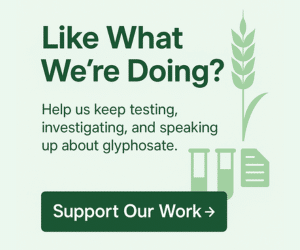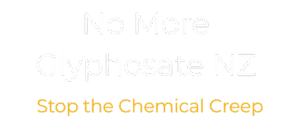For many of us, coffee is a daily ritual. The aroma of freshly brewed beans, the warmth of the cup in our hands — it’s how we start the day.
But alongside caffeine and flavor, could your morning coffee also come with a dose of glyphosate?
According to large-scale testing of store-bought coffees by the Clean Label Project in the US, most brands were free from harmful toxins. However, trace levels of glyphosate — the world’s most widely used weedkiller — were present.
The testing also revealed something more surprising: AMPA (Aminomethylphosphonic acid), glyphosate’s primary breakdown product, was detected in 72% of the coffee samples tested, including every organic coffee sampled. While organic standards prohibit the use of glyphosate, this finding highlights just how pervasive the chemical has become in soil, water, and the wider environment.
This wasn’t a token effort. The study covered 57 different coffee products, across 45 brands, with more than 7,000 individual tests run. That’s a massive campaign — the kind of large-scale testing we can only dream of here in New Zealand. One day, if funds and public interest allow, we’d like to see similar independent testing of coffees sold on our shelves.
On paper, the levels detected were well below official safety thresholds. That sounds reassuring. But it still raises an important question: what does “safe” really mean when it comes to a chemical like glyphosate?
Why Glyphosate Shows Up in Coffee
Coffee plants are often grown in large monocultures where weeds can become a problem. Glyphosate may be used to clear surrounding areas or as part of broader land management practices. Because glyphosate is systemic, it can linger in plant tissues if exposure occurs, and residues can persist in the beans even after they’re harvested, roasted, and packaged for sale.
In addition, glyphosate doesn’t just disappear after it’s sprayed. It can move through soil and water, creating environmental pathways into crops far beyond its initial application site.
The Numbers Look Small — But Are They?
Testing revealed only trace amounts of glyphosate in coffee, comfortably under the “maximum residue limits” (MRLs) set by regulators. But here’s where it gets tricky:
- MRLs are not health-based limits — they’re set at levels expected when pesticides are used according to approved farming practices. Regulators check that these levels fall below toxicological safety thresholds, but the starting point is agricultural practice, not human health.
- Safety assessments typically look at one chemical at a time, not the cocktail of exposures we get daily through food, water, and the environment.
- Chronic low-dose exposure remains poorly studied. Even tiny amounts, consumed regularly, could add to our body’s chemical burden over time.
So while each cup of coffee may be considered “safe” in isolation, the bigger picture is less clear.
What Consumers Can Do
If you’re concerned about glyphosate in your morning brew, here are a few practical steps:
- Choose organic coffee: Certified organic beans should be grown without glyphosate or similar herbicides.
- Support transparent brands: In other parts of the world, some coffee producers voluntarily test for pesticide residues and publish the results. Here in New Zealand, we haven’t yet seen that level of openness in the coffee industry — but there’s no reason we couldn’t demand it. Imagine if our local coffee companies tested their beans and shared the results publicly.
- Think beyond coffee: Reducing exposure isn’t just about what’s in your morning cup of coffee. Cereals, bread, honey, and other everyday foods can also carry glyphosate residues.
A Wider Conversation
Coffee is just the latest reminder of how deeply glyphosate has embedded itself in our food system. Even in products where contamination isn’t expected, trace residues are showing up. Regulators assure us these levels are “safe.” But safe for whom? Safe for how long?
Independent testing is essential because it keeps both industry and regulators honest. Without it, we’d simply be asked to take their word for it.
A Question Worth Asking
You shouldn’t have to wonder whether your morning coffee comes with a side of weedkiller. While testing shows that levels of glyphosate in coffee are low, the bigger issue is cumulative exposure — the way small daily doses across multiple foods add up.
For now, your coffee may be “safe.” But the real question remains: how much glyphosate exposure is too much when it’s everywhere?
Resources & References
When it comes to glyphosate in our food and drinks — even in something as everyday as coffee — the details matter. Independent testing, global health agencies, and investigative writers all offer different pieces of the puzzle. The resources below provide a wider lens, so you can see how coffee fits into the much bigger conversation about pesticides, health, and regulation.
Clean Label Project – Coffee Study
https://cleanlabelproject.org/coffee-study/
Independent testing of 57 coffee products across 45 brands, with more than 7,000 tests for contaminants including pesticides, heavy metals, and mold toxins. Trace glyphosate was detected but below regulatory thresholds.
World Health Organization / IARC – Glyphosate Classification
https://www.iarc.who.int/featured-news/media-centre-iarc-news-glyphosate/
In 2015, the International Agency for Research on Cancer (IARC) classified glyphosate as “probably carcinogenic to humans,” sparking global debate and regulatory reviews.
European Food Safety Authority – Glyphosate Safety Assessment
https://www.efsa.europa.eu/sites/default/files/2023-07/glyphosate_factsheet.pdf
A detailed factsheet outlining EFSA’s latest scientific assessment of glyphosate, covering human and environmental health data from many studies.
Environmental Working Group – Pesticides in Food
https://www.ewg.org/foodnews/summary.php
EWG’s annual “Dirty Dozen” and “Clean Fifteen” lists help consumers understand pesticide residues in fruits and vegetables. While coffee isn’t included, the findings show how common pesticide exposure is in the food supply.
US Environmental Protection Agency – Glyphosate Overview
https://www.epa.gov/ingredients-used-pesticide-products/glyphosate
EPA maintains that glyphosate is safe when used as directed, providing insight into how US regulators view the herbicide compared with global watchdogs.
Time – Are Pesticides in Your Food Harmful?
https://time.com/7291075/are-pesticides-dangerous-maha-glyphosate-atrazine/
A recent article exploring the health risks of pesticides—particularly glyphosate—and offering practical tips for reducing exposure through dietary and lifestyle choices
No More Glyphosate NZ – Glyphosate in Honey: First Test Results
https://nomoreglyphosate.nz/glyphosate-in-nz-honey-first-test-results/
Independent testing in New Zealand honey jars revealed trace levels of glyphosate, raising concerns about residues even in products marketed as natural and pure.
No More Glyphosate NZ – Weet-Bix Glyphosate Test Results
https://nomoreglyphosate.nz/weet-bix-glyphosate-test-results/
Testing of one of New Zealand’s most iconic breakfast foods found glyphosate contamination, showing how exposure begins first thing in the morning.
Further Reading
Whitewash: The Story of a Weed Killer, Cancer, and the Corruption of Science
By Carey Gillam
https://nomoreglyphosate.nz/whitewash-carey-gillam-monsanto-expose/
An investigative deep dive into glyphosate’s history, the science linking it to health risks, and the influence of corporations on regulators. Essential background for anyone wanting to understand why “safe” isn’t always simple.
Toxic Legacy: How the Weedkiller Glyphosate Is Destroying Our Health and the Environment
By Stephanie Seneff
https://nomoreglyphosate.nz/toxic-legacy-stephanie-seneff-review/
MIT researcher Stephanie Seneff examines glyphosate’s potential role in chronic disease, gut health disruption, and environmental damage. Controversial, but an important voice in the debate.
Coffee may only be one sip of the story. Glyphosate has woven itself into cereals, bread, honey, and countless other foods we consume daily. These references are a starting point for questioning the official narrative of “safe” exposure — and for asking whether we should accept any level of weedkiller in our morning cup.
Image Source & Attribution
A big thank you to the creators at Unsplash for making their images freely available for projects like ours. The image featured on this page is by cami. You can explore more of their work here: https://unsplash.com/@casnafu.




